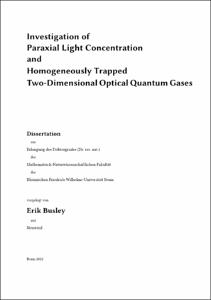Investigation of Paraxial Light Concentration and Homogeneously Trapped Two-Dimensional Optical Quantum Gases

Investigation of Paraxial Light Concentration and Homogeneously Trapped Two-Dimensional Optical Quantum Gases

| dc.contributor.advisor | Weitz, Martin | |
| dc.contributor.author | Busley, Erik | |
| dc.date.accessioned | 2022-07-15T12:53:44Z | |
| dc.date.available | 2022-07-15T12:53:44Z | |
| dc.date.issued | 15.07.2022 | |
| dc.identifier.uri | https://hdl.handle.net/20.500.11811/10087 | |
| dc.description.abstract | Trapped degenerate quantum gases in tailored environments allow for the investigation of otherwise unaccessible microscopic phenomena as they appear e.g. for the electron gas inside a solid. The field grew rapidly after the first Bose-Einstein condensate of dilute atomic gases was created in 1995, providing a very illustrative example for the effect of quantum statistics leading to a phase transition when the thermal wavelength of the constituent particles exceeds the mean interparticle distance. Apart from material particles, quantum gases of light can be realized in optical microresonators inside of which the photons interact with a medium. In the regime of strong coupling between photons and the medium, quasi-particles known as polaritons form. Those systems have allowed for the direct investigation of behavior such as superfluidity and superconductivity due to the here established combination of quantum degeneracy and instantaneous contact-like interaction. In our system, the photon gas is created inside a high-finesse optical microcavity that is filled with a liquid dye solution. The thermally related absorption and emission spectra of the dye molecules combined with the strong decoherence due to frequent molecular collisions of dye and solvent molecules allow for the creation of an ensemble that behaves closely to the ideal Bose gas. The short cavity length of several half wave lengths fixes the longitudinal mode number, rendering the gas two-dimensional. Variable potential landscapes for the photon gas can be established via mirror surface topographies, where spherically curved mirrors result in a harmonic oscillator potential for the photon gas and surface-structured plane mirrors can yield finite size box potentials.
In the present work, a quantum degenerate homogeneously trapped two-dimensional photon gas is experimentally realized, providing a novel platform for the investigation of uniform photon gases. Basic properties such as spatial, momentum and spectral distribution are successfully probed and found to be consistent with predictions for the ideal Bose gas at room temperature. Extraction of the specific heat for various photon numbers below and above criticality reveals the absence of a second-order phase transition as expected from theory. Mechanical tilting of one cavity mirror superimposes the trap with a linear potential gradient and allows from the responding density profiles to extract the equation of state and the isothermal compressibility of the gas. The latter is for the ideal Bose gas expected to diverge towards infinity when the system forms into a Bose-Einstein condensate as the macroscopically occupied ground state does not exert any pressure. Owing to the finite size of the sample, this behavior is validated in the quantum degenerate regime but breaks down in the condensed regime due to the nonzero ground state energy. In other work carried out in this thesis, it is investigated if the apparatus can be employed as a so-called solar light concentrator, as an initially prepared "hot" photon cloud in a harmonic trap is expected to redistribute towards the trap center when cooled to ambient temperature via coupling to the dye heat bath as could potentially be useful for photovoltaic applications. Compared to observed light concentration in dye-doped thin glass-plates that capture a certain fluorescence angle, the here investigated approach relies on systematic reabsorption of trapped fluorescence. Despite observing a shrinking of the cloud, we find that optical losses in the system presently prevent the system from experiencing a phase space density increase. | en |
| dc.language.iso | eng | |
| dc.rights | In Copyright | |
| dc.rights.uri | http://rightsstatements.org/vocab/InC/1.0/ | |
| dc.subject | Sonnenlicht | |
| dc.subject | Photonen | |
| dc.subject | Kompressibilität | |
| dc.subject | homogen | |
| dc.subject | sunlight | |
| dc.subject | photons | |
| dc.subject | compressibility | |
| dc.subject | homogeneous | |
| dc.subject | two-dimensional | |
| dc.subject.ddc | 530 Physik | |
| dc.title | Investigation of Paraxial Light Concentration and Homogeneously Trapped Two-Dimensional Optical Quantum Gases | |
| dc.type | Dissertation oder Habilitation | |
| dc.publisher.name | Universitäts- und Landesbibliothek Bonn | |
| dc.publisher.location | Bonn | |
| dc.rights.accessRights | openAccess | |
| dc.identifier.urn | https://nbn-resolving.org/urn:nbn:de:hbz:5-66651 | |
| dc.relation.doi | https://doi.org/10.1126/science.abm2543 | |
| dc.relation.doi | https://doi.org/10.1126/science.aay1334 | |
| dc.relation.doi | https://doi.org/10.1209/0295-5075/130/54001 | |
| ulbbn.pubtype | Erstveröffentlichung | |
| ulbbnediss.affiliation.name | Rheinische Friedrich-Wilhelms-Universität Bonn | |
| ulbbnediss.affiliation.location | Bonn | |
| ulbbnediss.thesis.level | Dissertation | |
| ulbbnediss.dissID | 6665 | |
| ulbbnediss.date.accepted | 12.05.2022 | |
| ulbbnediss.institute | Mathematisch-Naturwissenschaftliche Fakultät : Fachgruppe Physik/Astronomie / Institut für angewandte Physik (IAP) | |
| ulbbnediss.fakultaet | Mathematisch-Naturwissenschaftliche Fakultät | |
| dc.contributor.coReferee | Hofferberth, Sebastian | |
| ulbbnediss.contributor.orcid | https://orcid.org/0000-0003-2050-5316 | |
| ulbbnediss.contributor.gnd | 1268574708 |
Files in this item
This item appears in the following Collection(s)
-
E-Dissertationen (4395)




